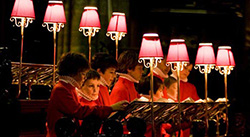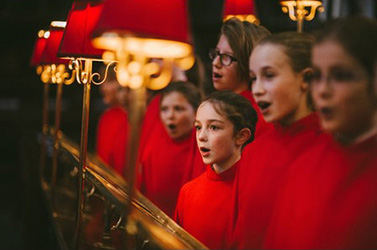Mike Dobson - memoirs of a long-serving alto
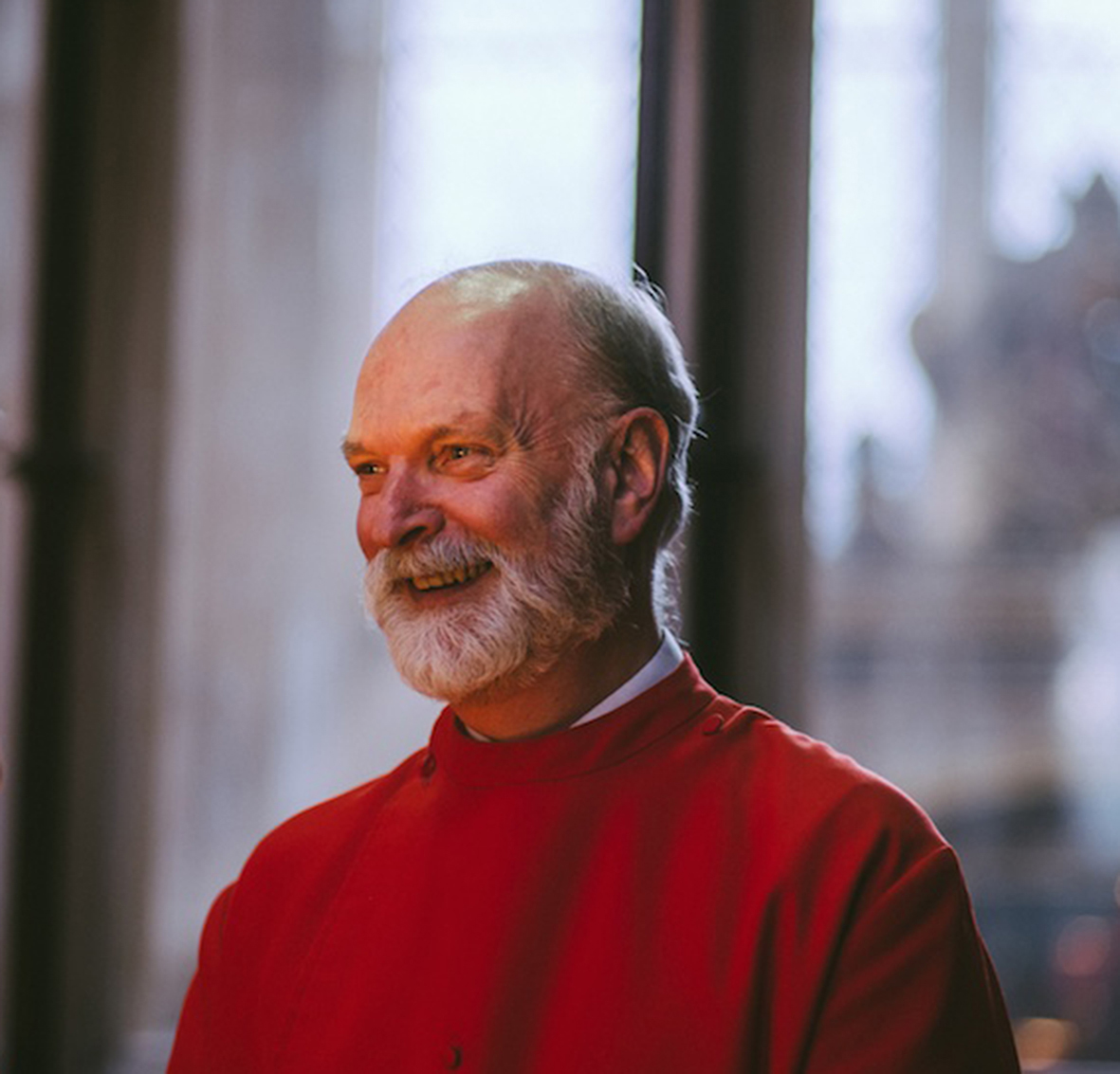 A request from the ECOCA Committee: “Could you write some memoirs of your time in the choir please, for the Newsletter? About a thousand words.” That’s a bit like trying to fit the 15th evening into two minutes. So, what follows is a bit like starting with verse one, a few changes of chant and then skipping to the Gloria. And just like we omit the really juicy verses when we sing psalms … something for Easter Monday post-dinner, wine-fuelled conversations.
A request from the ECOCA Committee: “Could you write some memoirs of your time in the choir please, for the Newsletter? About a thousand words.” That’s a bit like trying to fit the 15th evening into two minutes. So, what follows is a bit like starting with verse one, a few changes of chant and then skipping to the Gloria. And just like we omit the really juicy verses when we sing psalms … something for Easter Monday post-dinner, wine-fuelled conversations.
It all began in the autumn of 1976, when I started as an undergraduate at Exeter University, studying History and Archaeology, and became an alto choral scholar. I joined in the same term as Julian Sutton (bass lay vicar and later punctator) and John Turner (bass choral scholar and later secondary). But at long last, in July 2023 I hung up my cassock for the final time; the last of the 1976 brigade.
As the saying goes: “I’ve seen them come, I’ve seen them go”. For me this means (as accurately as I can remember) and resembling a version of the “Twelve Days of Christmas”: three Directors of Music, five Assistant Directors, seven Deans, four Bishops, seven Precentors, six Treasurers, five Chancellors, four Succentors, seven Head Virgers, eight Headmasters and five Punctators. I have also witnessed two organ rebuilds, one new chamber organ, several grand pianos, two sets of song schools, two sets of nave stalls (the 1970s set are still for sale in a local antique centre!), two sets of quire stall lights (both equally badly designed and annoying) and probably the only period of interruption in the choir’s singing since the Commonwealth (caused by Covid). I don’t know how many choristers have passed through the stalls in front of me, but I guess it could be over 250. As for the number of lay vicars and choral scholars, I have no idea, but it will be a significant number. And so it comes to pass, but very sadly, it’s now my turn to “see them go”.
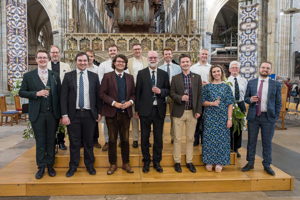 |
Farewell drinks, Sunday 2nd July 2023, after evensong (click on image for a larger version) |
Another amusing statistic. The procession from the vestry to the quire stalls is about 100 metres. If to that is added other processions for Christmas, Easter, etc., it means I have processed for a distance longer than walking from Exeter to Edinburgh (i.e. over 450 miles!!). No wonder I have got through numerous pairs of black shoes over the years! As for the number of times I have sung a particular psalm, Mag & Nunc, anthem etc … no idea. Some of them I can now even get right!
I still remember my audition with Lucian Nethsingha. It was in the old, stone-vaulted song school above the chapel on the north side of the quire. Many of you may remember that a particular stone in the vaulting near the door of the song-school used to crumble when we sang loudly or the trebles sang very high – the powder used to land on my copy; and as for a fire exit … health and safety didn’t get a look in! I remember one of my sight-reading pieces was Howells Gloucester Service. Lucian insisted that I held on to those very long notes at the end of several phrases, right to the end, to see how good was my breath control! My prepared piece was Gibbons ‘Record of John’. Little did I know how many times I would go on and sing that with the choir, including recording it for West German Radio and Swiss Radio, as well as it being included on a choir cassette recorded in 1991. I was the only candidate being auditioned for the one alto choral scholar vacancy remaining, but Lucian gave no indication whether I was good enough. That had to wait for a letter through the post a couple of weeks later.
There were only three altos that first year. I was one of two alto choral scholars on Decani; on Cantoris there was a lay vicar. The first few months were a very steep learning curve. I knew hardly any of the repertoire as I had not been a cathedral chorister. For the first term at least I could learn from the experienced (postgraduate) choral scholar next to me, Gary Jones, who had been a choral scholar at Christchurch Oxford, opposite James Bowman; I was so in awe of Gary singing with my ‘alto idol’ – I was not to know that years later I would become acquainted with James Bowman, perform solos in front of him and even duet and sing with him. But at that first, 1976 Christmas, the Cantoris alto lay vicar (Colin Broughton) left, seemingly rather unexpectedly (and I never found out why). That meant I went over to Cantoris and there were just two altos for the rest of the year. To say I found that challenging is an understatement. Brian Hann (bass lay vicar and later punctator) once told me that singing in a cathedral choir was basically “hours of boredom, punctuated by seconds of terror”. That second term for me was quite the opposite! Thankfully the Cantoris tenor choral scholar next to me, Mark Johnstone, usefully sang corrections and prevented too many ‘variations on a printed theme’. My first year was Andrew Nethsingha’s year as a probationer.
I returned to Decani during the second year and was on that side since (in the late 1990s there was a slight interruption in my full-time activities in the choir due to family reasons, but I never completely left as I frequently depped for Brian Northcott, job-shared with him for a couple of years and then returned to full-time). For the first few years, the composition of the alto section changed frequently, with some choral scholars only singing for one or two years. One alto choral scholar was even required by the Dean & Chapter to leave the choir after he had failed his university first year and was unemployed. It was felt at the time that an unemployed member of the back row would set a bad example to the boys; thank goodness attitudes to unemployment have changed!! A lay vicar (Robin Davidson) was not appointed until 1978, so the alto section was purely choral scholars until then. It was not until 1980 that we actually had four altos (1979-1980 there had been only two of us, as there had been from the Christmas during my first year) and it has been three or four since then. Thankfully, with the introduction of female altos by Andrew Millington (Anna Rose was the first), we have usually been able to have four altos every year. The presence of the ladies also has the wonderful benefit of taking the strain out of any top Fs – Bruckner’s Ave Maria can now be approached with a smile! Also, an interesting non-musical side-effect of having female altos, is that it was noticed it caused a reduction in flatulence and audible belching in the adult vestry (though one particular female alto choral scholar - later my replacement as lay vicar - was especially skilled at the latter!)!
I can’t remember exactly when I was made a lay vicar. There used to be a rule that a lay vicar could not be in full-time education. As I was doing a PhD from 1979, it meant I was in that state until about 1983, so I guess it would have been about then. I remember Martin Shaw was Succentor at the time, and he organised the installation.
For many years, the convention among the adults was to call everyone Mr surname and never use first names, even in general conversation. The choristers were similarly called just by surnames. This changed when the girl choristers started, as it was felt inappropriate to call them in this way and so all choristers were referred to by first name to avoid any discrimination in practices. It was many years before I had the courage to call Lucian by his first name. But I was not alone in that; for a very long time, only Brian Hann had the privilege of using Lucian’s first name. The same applied for when talking to the Dean and Chapter. Always ‘Mr Dean’ or ‘Canon Precentor’ etc. never first names. But fashions change, and from the late-1990s first names were increasingly adopted, even for members of Chapter. But that did not guarantee that Lucian would remember your name. After many years in the choir, the name of Mr Phil Hobbs (tenor lay vicar) escaped Lucian during a rehearsal, and he merely said “Whoever you are” ¬– much mirth followed! Relating to that, choral scholars used to have to write a letter to Lucian to claim expenses for the days they sang when the university was on vacation. Such letters had to be meticulously worded and the envelope properly addressed to either Mr L. Nethsingha or L. Nethsingha Esq. They would be returned, unopened, if not suitably addressed.
So many changes and so many events have happened during my years in the choir. I could and perhaps should write a book. Some of the things, and the progress of the hair on the top of my head slipping down to form a beard, as well as also becoming grey, can be seen in the photographs on the ECOCA web pages. Space permits only a few things to be mentioned here.
Choir tours started in 1982, thanks to the efforts of Mark Perry (tenor lay vicar), who, compared to what is common now for cathedral choirs, surprisingly had to persuade the Dean & Chapter that they were a valid activity for a cathedral choir (but then, at that time, the Dean & Chapter could not see the point of having a cathedral shop!). The first tour was to northern Germany. There followed a period of tours about every two years, then every year once girl choristers began in 1994, with the boys and girls alternating each year; more recently it has been the practice of taking the senior boy and girl choristers on the same tour. Rising costs, ensuring appropriate safeguarding and then Covid have meant that tours are proving more difficult and have become less frequent. Regrettably, I did not go on all of the tours as I did not like flying until relatively recently.
As the saying goes, “what happens on tour, stays on tour”, and relating all our adventures would require so many words, but I should mention a few highlights. We sang Eucharist in St Mark’s Venice, an amazing experience, though we never saw the service as we were up in a gallery, and a priest standing beside Lucian told us when to sing and to stop – the latter even if we were not at the end of a piece (which included Monteverdi’s Cantate Domino!). When recording for West German Radio, the producer was, shall we say, ‘demanding’. Lucian had enough of the repeated comments about how we were singing Britten’s Jubilate, and firmly but quietly said “I am sure that is how Ben would have liked it sung”. No more recording takes after that. A tour to Rome saw us singing Eucharist in St Peter’s Basilica. A wonderful and amusing experience, caused by us having three of their operatic tenors providing parts of the service, and the organist using an electronic keyboard to work out the pitch the priest was singing at so that he could follow with the accompanied response. Returning home from a tour to Lugano, in a coach driving through the night on motorways, John Turner saved the lives of the choir when he noticed the driver had fallen asleep at the wheel and so he ran the length of the coach to wake him up. Thanks be to John!
Some characters from the congregation that may jog a few smiling memories for readers: Captain Kettle, Oddsocks, The Polish Baron (a very tall man, on regular day-release from Digby mental hospital, who always sat opposite the Bishop’s Throne), Graham (of loud and late "Amen!!!" fame), Prof. Walter Minchinton (with his unofficial 'reserved' stall at the back of Cantoris quire stalls for the Sunday morning Eucharist and even came up to Phil Hobbs to talk to him in the middle of a concert in Dawlish parish church - Lucian was furious and uttered unprintable things afterwards!), the gentleman who always attended Matins in very sombre attire, and drove a really old, huge car - he also insisted on continuing to sit in the nave for Sunday Matins after that service had been moved into the quire in the early 1980s due to reduced congregation numbers (the Eucharist was conversely moved into the nave at the same time, due to increased numbers).
During my time, the choir has sung for many members of the Royal family, some of them more than once; but sadly not for the Queen Mother or Diana. This included the amazing Maundy Service in 1982, when we were each paid the official fee of a set of Maundy money. We sometimes talked to the royal visitors after services. On one such occasion during the mid-1980s, and relating to the Music Foundation for which (the then) Prince Charles was patron, his visit to the vestry included the questions, “Do you have any altos? Are they the ones with the pained expressions on their faces?” (much laughter, but curiously no-one disagreed with him!). He then asked me if the boys were well-behaved (I even have a photo of that conversation taking place).
I was involved in numerous choir recordings. These started with LPs, then as technology developed, cassettes and CDs. Many of the early ones were made by Harry Mudd of Abbey Label; curiously for a record producer, he was deaf in one ear. Most of these can be listened to on the ECOCA website: http://www.ecoca.org/recordings.html Amusingly, or is it curiously, I have never actually listened to many of these; some are even still sealed in their plastic wrappers!
There have been numerous BBC choral evensongs (listed at http://www.ecoca.org/recordings.html). It was interesting to see how these sessions changed over the years. They started with several vans outside the cathedral, many cables, a telephone then satellite connection to London and in wonderful BBC old-style convention, all the staff wore suits. The number of vans steadily reduced, until recently when there was just a car, an internet link and fewer cables; but the wonderful large brass microphone bases are still used. Suits are sadly less in evidence now. It is also lovely to see that the current BBC choral evensong producer is Ben Collingwood, a former Exeter bass choral scholar.
There were several TV recordings over the years, as well as numerous small news items. As with the radio, the amount of equipment and staff for these has steadily decreased to become very small, a news item sometimes now just being one person with a camera and doing everything. One TV session was in a Plymouth studio, where we were interviewed by Prebendary Parkinson, who was the media link person for the cathedral. Does anyone remember his infamous sermon in the cathedral one Sunday afternoon? Until about 1990, all prebendaries had to preach twice a year in the cathedral at Sunday evensong. The boys went out before this, meaning that two adults took it in turns to clear the books after the service, a role usually performed by the ‘book boys’. Such ‘book choristers’ ceased some years ago, with music being carried in and out in procession; I think the book choristers stopped in about 2012 when the new song schools started and rehearsals took place mainly in them rather than in the stalls (though this reverted back to rehearsals in the stalls when the Dean & Chapter allowed rehearsals to go on much closer to 5.30, and particularly from when Covid restrictions came in). Getting back to that sermon. The prebendary declared at one point that his “village was full of living orgasms”. He foolishly tried to correct this to what it should have been (organisms); this only made the laughter worse. One tenor even had to stuff his surplus into his mouth to prevent his laughter being audible. Back in the vestry, John Thurmer (Chancellor) turned and said to the prebendary, “you live in a very interesting village, prebendary”. More laughter and a further red-faced preb.
Who remembers Father Venn? He was a retired clergyman and Priest Vicar of the cathedral who regularly attended on Sundays. Julian Sutton (bass lay vicar and punctator) provided car lifts to and from Father Venn’s house. In return, Julian was provided with a lovely Sunday lunch in the White Hart. The consequence was several red-wine 'blurred’ evensongs for Julian. Does anyone remember Father Venn’s quick exit during one evensong? We returned to the vestry to see a trail of his vestments across the vestry floor, as he had cast them off as quickly as possible to reach the toilet as unencumbered as possible.
Father Venn also enters the story of the Exeter scarlet cassocks. During the mid-1980s, as a consequence of the Queen commenting during a Maundy Service at Rippon about whether that choir was entitled to wear the scarlet of royal cathedral foundations, the Master of the Wardrobe (the then Bishop of Wells) sent a letter via the Lord Chancellor’s office to all cathedrals questioning their right to wear scarlet cassocks. I was living in a flat in the Deanery (now the Old Deanery) at the time (my flat was the block on the north side that looks like two aisles of a chapel – I wrote most of my PhD thesis on a desk at the back of the part that was still actually a chapel!), and picked up the letter, with its grand seal on the envelope, when it was delivered unceremoniously with the post to the Deanery back door. I gave it to the Dean (Richard Eyre). He looked puzzled, but did not realise what a turmoil would follow as a consequence. Cutting a long story short, the cathedral was unable to definitively prove that it was a royal foundation and so would have to cease wearing scarlet cassocks. During the debate, it was mentioned to Father Venn that he would have to cease this practice as well. It turned out, though, that he was the only person of the cathedral clergy actually entitled to wear scarlet, as he had been a Queen’s Chaplain. No one realised this! The outcome of the whole episode, was that it was agreed the cassocks could be blood red. The Dean had proposed this colour on the basis that it was the colour associated with St Peter. Thankfully, the choir were allowed to keep the scarlet, as their cassocks had only relatively recently been replaced (the heavy woollen ones that I started with, were replaced by synthetic fabric ones during the academic year 1977-78), but on the understanding that they too would become blood-red when they needed replacing (which was not until about 2018 though!).
But it is not only what we wore on the outside that changed. When I started, there was quite a strict dress code for the adults. White shirts, ties, black shoes and suits on Sundays, for concerts and important occasions (that continued until 2023, when the white shirt and tie rule was eased, because it was acknowledged that the white neck scarf - introduced with the 2018 new cassocks - covered what was being worn underneath). Weekdays could be more casual, but definitely no jeans, brightly coloured trousers, shorts or sandals. I was once asked to role up some green trousers so that they did not show below my cassock. But then one hot summer, John Thurmer (Chancellor) said he was wearing shorts under his cassock. The flood gates opened. We could then wear shorts too. Apparently, I was famous among some choristers for my shorts! I and some others even strayed into the dizzy extreme of wearing sandals for a while, but ‘sensible’ casual shoes became the norm for weekdays; no trainers or brightly coloured shoes allowed though. The formal ‘Sunday attire’ generally remains, an excellent piece of tradition, but otherwise things have understandably relaxed as fashion became more informal. White shirts are even less a requirement, as we have worn white neck scarves since the cassocks were changed a few years ago, and so any shirts are covered and we all look the same. Shorts are common. Even the current Director of Music wears them occasionally! Footwear was standardised relatively recently to black shoes, for all services, by Dean Jonathan Draper. The result is a wonderful array of black shoes 'stored' (i.e. usually dumped in a pile under a bench) in the vestry for changing into before services!
The nature of choir conducting has changed over the years. For quite a while, the Director of Music (the title of this role changed over the years, from ‘Organist and Master of the Choristers’, through ‘The Organist’ to the current ‘Director of Music’) only conducted at weekends, because the assistant organist (Paul Morgan) and he were both in the cathedral at the same time. Mondays, Tuesdays (Wednesday was no choir) and Thursdays, ‘conducting’ was by an adult beater on each side, one of which would be the punctator (there used to be two punctators up to the mid-twentieth century, one on each side), as there would only be one organist in the cathedral those days. Friday was conducted by the Director of Music as the service was unaccompanied. This changed when Paul Morgan was able to be in the cathedral for all services (due to the Music Department closing at the university, where Paul lectured part-time) and the Director of Music could conduct Mondays and Tuesdays (from 1994, when the girl choristers started, Stephen Tanner, the director of the girls, conducted Mondays, which was the girls’ evening, and then also at the other girls’ services as they took on more). Thursdays still used the beaters as the Director had Wednesdays and Thursdays off each week. This changed again from Andrew Millington’s time, with Thursdays having ‘both organists’ in the cathedral. Since Andrew, there has been little need for the beaters, as the assistant organists (Since 2016 called Assistant Director of Music) have always been full-time.
How many of the ‘older’ former choristers remember the hinged kneelers in the quire stalls? How often were your toes caught underneath the wooden supports as the seniors brought the kneeler down and pinned your feet, with the full weight of the other choristers on the kneeler? The adults had the same type of hinged kneelers. I too remember the pain! Thankfully, after yet one more tear-streaked treble’s agony, these were removed in the early 2000s, as I pointed out to the then Precentor that they could be a serious health and safety issue, with the potential for broken bones, and the cathedral could be legally liable.
One of the biggest changes in the history of the choir that I witnessed, was the introduction of girl choristers in 1994. The first the back row knew about this was an article in The Guardian newspaper (!) At the time, there was so much debate about this introduction, now, thankfully, largely committed to history. Some people said to me at the time that, of course, the girls will never sing in ‘important’ services and one person even said they will never sing on Sundays! Astounding comments!! Personally, I think it was an excellent development and the cathedral and music-making have benefitted enormously. It has been wonderful to see how the girls have steadily increased the number of times they sing and now the boys and girls have an equal, shared role providing the top line. Also personally, it meant that my daughter Ginevra could sing in the choir and has provided her and many other girls with an excellent foundation to go on to professional singing careers.
Needless to say I have some favourite pieces: these include anything by Purcell or Gibbons, Bairstow Blessed City, Howells St Paul’s and Gloucester, Bruckner Locus Iste and Os Justi, Croft God is Gone Up, Vaughan Williams Mass in G Minor, Requiems by Fauré and Duruflé, Wesley Ascribe and Wilderness, Duruflé Ubi Caritas, the list goes on … even some organ items: Howells Master Tallis Testament, Alain Litanies, Liszt Prelude and Fugue on BACH.
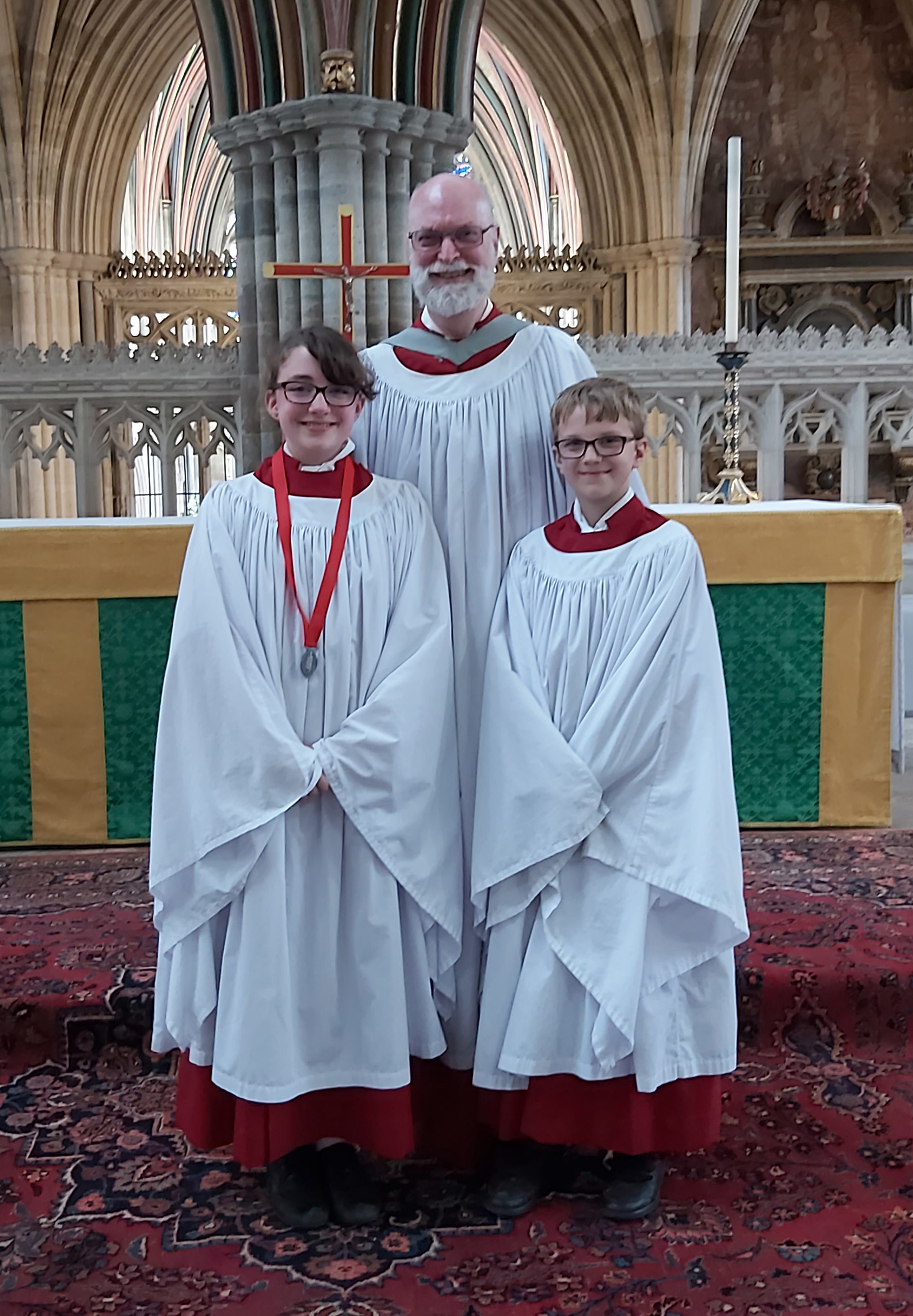
How would I sum up the past 47 years? A wonderful privilege to belong to a very special club. Life-long friendships and god-parents for my children. Seeing and hearing both Ginevra (chorister 2017-2022) and Freddie (chorister 2020-2025) develop as choristers in front of me, feeling so proud of them talking to Charles and Camilla when they visited the cathedral in the summer of 2021, and regularly receiving their criticism of my efforts in the car on the way home! Who knows, perhaps the Dobson presence and another rendition of Record of John may one day return at the end of the Decani stalls through them?
March 2023 and subsequent edits
left: Ginevra, Mike and Freddie, photographed in July 2022

